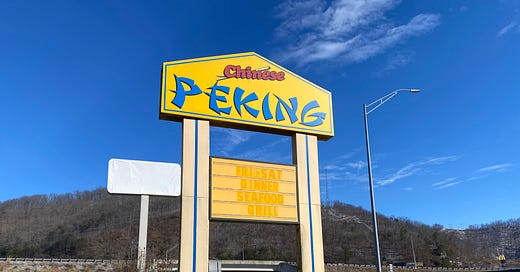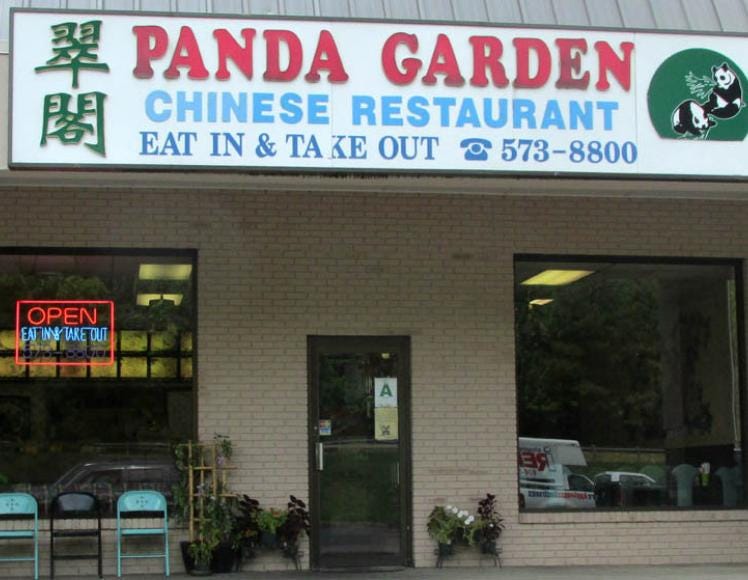The Systemic Struggles Faced by Asian-Owned Restaurants in Rural Kentucky
"After two years of xenophobic narratives...compounded by a lack of interest or resources to build trust between local media and AAPI, who has the energy to continue the narrative?"
On The Goldenrod today, we have food and drink labor writer Michelle Eigenheer with a more personal essay about her efforts to report on how Asian-owned restaurants in rural Kentucky are doing two years into the pandemic—and the difficult realities she discovered in the process.
2021 saw a 339 percent increase in anti-Asian hate crimes, according to the Center for the Study of Hate and Extremism, and 2022 has already seen a terrifying number of anti-Asian violent attacks—particularly against AAPI women. If you’re looking for ways to donate in support of Asian communities, this list is a good place to start.
“Good food is a matter of taste” read a syndicated column headline in papers from Stanford, Nicholasville and Danville. Below, a man’s accounting of the times in his life he’d attempted to eat new foods he didn’t recognize or didn’t want—calamari, then sushi, then lobster—and each time he regretted not “learning his lesson” the time before. Great food, he said, is the food he ate from his mother’s cast iron skillet. Bad food, he implied, was that which was foreign to him.
(A snippet from the article, via the Danville Advocate-Messenger)
As an Asian American food writer, I know as well as anyone that food is a vital part of the relationships we nurture. We gather around tables to share meals for family events, holidays, celebrations, first dates. We bring food to loved ones who are sick or grieving. We stow cherished recipes in precious boxes and beg grandparents to share their secrets before they leave us. We savor food for nourishment, comfort and the taste of the homes we have left behind. Our olfactory receptors—our sense of smell—are the strongest trigger we have for memories. When I smell kimchi cooking in a pan or ginger simmering in a pot, I see my mother manning three pans at once to cook my favorite meal for my birthday.
I found the op-ed as I dug through newspapers across the state, looking for clues about how Kentucky’s Chinese and Asian-owned businesses were doing two years in the pandemic. It made me pause my search, feeling the familiar creep of shame and embarrassment I’d experienced in childhood each time someone had called the food at my home weird or gross years before bulgogi tacos and kimchi aioli found their way into culinary pop-ups and onto New American restaurant menus. I was angry at the absurdity. Why would you ever put something into your mouth without knowing what it was? And then complain that it wasn’t what you expected? How could this be a problem with the food and not the writer?
I moved on in my search.
It was important, I’d pitched, to take a look at the recovery from a crisis that not only crippled the restaurant industry, but uniquely targeted Asian-owned businesses as a consequence of xenophobic rhetoric that has resulted in a 339 percent increase in anti-Asian hate crimes nationwide in just one year, because I knew that many of them have come out of the worst of it intact with stories to tell.
I’d heard anecdotes from friends around the state about locals rallying around small town Chinese restaurants to help maintain business and morale as restaurants began closing up shop due to COVID safety measures, and then due to supply chain and labor challenges, before many shuttered completely, unable to weather a crisis that does not have an end date. A January 2022 Kentucky Restaurants Association survey of its members reported that 47 percent of respondents had seen a drop in profitability since the start of the pandemic and 55 percent had accumulated additional debt.
But specifics on that subset of restaurants—ones owned by Chinese Americans; ones at a greater risk of danger and financial damage as use of the term “China virus” continued—was absent.
(Peking Chinese, Prestonsburg)
I know that the stories of community support are not ones that are expected in the prevailing narratives of Kentucky, Appalachia or rural America. I’ve watched eyes widen when I tell people about where I grew up. There are more—better, truer—stories to tell than the ones that dominate Kentucky’s national reputation and narrative. The region is home to one of the largest refugee resettlement areas in the country, welcoming immigrants fleeing conflict. And thousands of healthcare workers serve the state of Kentucky through H-1B visa programs, making a significant part of the population that treats a region that suffers some of the highest rates of chronic illness and disease in the country and a lack of health care workers.
But local media, where power in telling stories begins, suffers from a lack of resources and subscriptions, putting limits on the number of stories they can uncover.
And in this case, there was a lack of local news coverage about many parts of the issue: limited reporting on how restaurants were faring after the initial announcement that dining rooms would be mandated to close. While some papers ran full spreads highlighting specific Asian-owned restaurants and their long-held stakes in their communities, these stories were outliers. I found that many newspapers had select stories from the AP wire about China, but none about the Chinese Americans living in their own communities.
And the information from Kentucky Restaurant Association CEO Stacy Roof sent its own message. When I reached out for data and insights into the industry situation and Asian-owned restaurants, she told me she couldn’t be much help beyond the member survey, which didn’t include the restaurants I asked about. “In my experience they haven't been members of KRA, they have their own group they belong to,” she wrote in an email.
I wondered how that would preclude them from being part of the primary association in the state. And I asked, along with questions about whether any effort had been made to engage them or offer support, especially when it became clear that they would need it. After all, campaigns emerged early in the pandemic to save Chinatowns across the US and to Stop AAPI Hate.
“All restaurants are welcome to join KRA, but I can only think of a couple of places that are specifically Chinese that are members,” Roof wrote. “In my experience, most restaurants are not members of multiple associations. Membership is voluntary and we represent all restaurants in the state, we do not categorize by market segment.”
I reached out to Asian chefs who told me that they weren’t surprised. The relationship had long been contentious, they described, boiling it down to a lack of cooperation and patience in bridging language barriers, especially as it related to paperwork and logistics.
But no one wanted to go on record, even restaurant owners asked to comment on how their businesses were recovering. “I won’t have time,” Joyce Cheng, who owns Panda Garden in Harlan, told me. “I [don’t have] backup [from any] worker this week.”
(Panda Garden, Harlan)
In addition to the basic challenges of time and labor, cultural issues present a challenge. Across Asian American communities, a movement has grown to increase voter turnout and engagement among populations that have long been seen as disengaged from politics. In 2020, key states saw dramatic increases in AAPI voter turnout: +84 percent in Georgia and +71 percent in Texas. Nationally, the number of AAPI voters almost tripled compared to 2016.
There are a lot of interpretations for why Asian communities have historically lacked a significant voice in political discourse—explanations that range from a general disengagement; a reluctance to challenge American politics for fear it will increase perpetual foreigner syndrome; a lack of economic and social resources; alienation by politicians who do not seek to engage Asian communities; and language barriers. The explanations are endless, and they are flawed.
In this situation, I can’t help but think it’s fairly simple. After two years of xenophobic narratives and an endless stream of news about violence against Asian Americans, compounded by a lack of interest or resources to build trust between local media and AAPI communities, who has the energy to continue the narrative? Why would anyone be willing to share their stories after seeing all that has unfolded?






